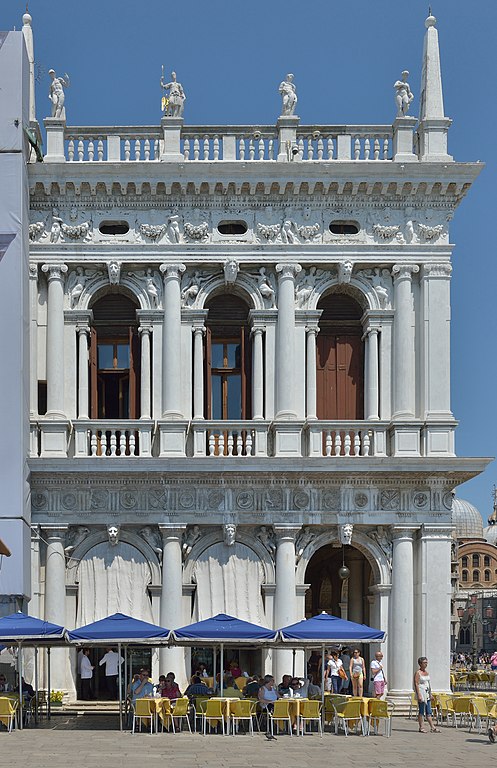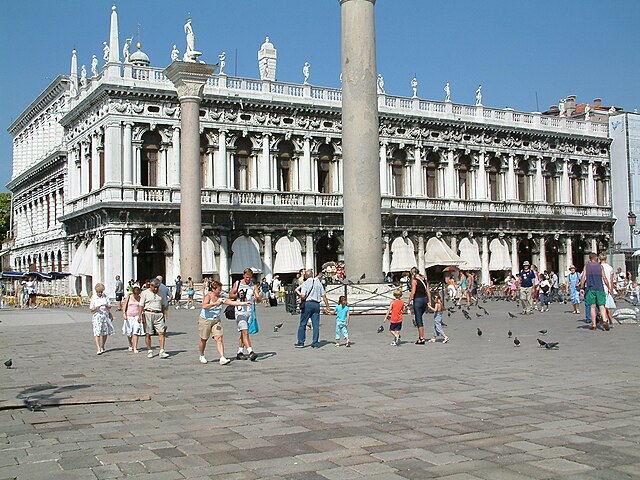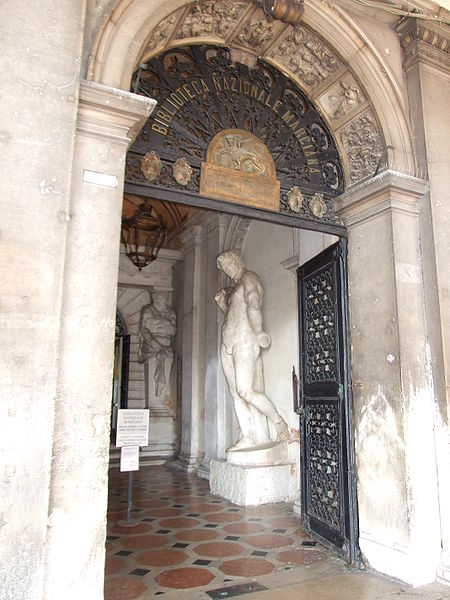
National Library of St. Mark’s, Venice, Italy.
The National Library of St. Mark’s (Biblioteca Nationale Marciana) is a library in Venice, named after St. Mark, the patron saint of that city. It was first built in the 1500s, but much of the collection is even older. Owning around one million printed books, the Biblioteca Marciana also has 13,000 manuscripts and many other treasures. It is one of the landmarks of Venice, a city in northeastern Italy world-famous for its scenic setting. Venice consists of over 100 little islands connected by bridges over canals. Because of this, motor vehicles are rare in Venice, although motorboats on canals can make noise and pollution that are familiar parts of life in all cities. Venice has been called the City of Water, the City of Bridges, the Floating City, and the City of Canals.
Digitization projects.
The many unique items in the Biblioteca Nationale Marciana collection have inspired an ambitious project of digitization. In a 2011 interview for the Digital Curator Vocational Education Europe Project, Dr. Maurizio Messina, the library’s deputy director, spoke about the main motivation of digitizing:
To facilitate citizens’ access to resources, stimulating sensitivity and encouraging cultural institutions to implement digital preservation programmes for their own digital resources.
As a representative of the Ministry for Heritage and Cultural Activities in the Coordination Action Digital Preservation Europe, Dr. Messina is enthused that in Italy, leading libraries of Florence, Rome, and Venice have agreed with current laws to encourage preservation of materials. This means a
strong commitment for national libraries to set up the foundations of a National Digital Preservation Network…We are working hard to achieve the following three main goals: First, to implement an organizational model suitable for creating the national and regional archives of electronic publishing production, with a view to extending this model to the electronic resources of Archives-Libraries-Museums (ALM) sector; second, to implement a service model suitable for balancing the rights-holders interests in content protection with the final users rights in contents access; and third, to implement a system suitable for ensuring long-term preservation and access to digital content, as well as its authenticity [identity and integrity].

One important aspect of this effort deals with Persistent Identifiers (PI):
Persistent identification of digital resources and their authors is a crucial issue for the whole information society. Persistent and unambiguous identification of digital resources is a fundamental issue for enabling their granted accessibility and re-usability over time.
Uniform Resource Name (URN) and National Bibliography Number (NBN) are useful for items that would otherwise have no identification, for example doctoral theses or digital copies of books printed before ISBN numbers existed. Now NBN is being used in Italy to identify all digital cultural resources, including those which also have an ISBN or other code numbers.
Thailand and Italy
In January, it was announced that Thailand and Italy are planning a joint business forum. H.E. Mr. Francesco Saverio Nisio, the Italian Ambassador in Thailand met with Thai officials, looking forward to Expo 2015, the Universal Exposition currently being hosted in Milan, Italy. The exposition, which includes an exhibit from Thailand, opened in May and will close at the end of this month. Expo 2015 has the general theme Feeding the Planet, Energy for Life, and the Thai Pavilion emphasized Thai agricultural tradition, as well as the importance of water. A floating market, rice field, and fish, are all on view. Naga, the royal serpent symbolizing water and fertility by connecting rivers with fields, is also visible. The main hall of the Thai pavilion is in the shape of a Ngob, the hat worn by rice paddy workers. Thailand is already familiar to over 250,000 Italian tourists who arrive every year. The website of the Italian Embassy in Bangkok offers information about courses in Italian language, as well as Italian Government scholarships offered to Thai students for graduate, post-graduate and single course studies as well as research at Italian universities. These scholarships are for many fields, including language/literature; physics; information technology; sciences; civil and electronic engineering; agricultural and food industry; environment; telecommunications; energy; micro- and nanotechnology; conservation and technology of restoration; aerospace; arts; and music.

In 2013, in The Big Chilli, Italy’s previous ambassador to Thailand, HE Michelangelo Pipan, spoke of the ties between the two countries. He reminded readers that many famous buildings in Bangkok were created by Italian architects and builders. They include the Apisek Throne Hall, Audience Hall at Phya Thai Royal Residence, Hua Lamphong railway station, Villa Norasingh (the Government House), the Makawan Rangsan Bridge, Amporn Sathan Royal Villa, Ananta Samakhon Throne Hall, The Royal Turf Club, and Mrigadayavan Palace. Silpa Bhisari, born in Italy with the name Corrado Feroci, worked on the Democracy and Victory monuments. Another Italian, Galileo Chini, painted frescos in the Ananta Samakhon Throne Hall. Ambassador Pipan explained that diplomatic relations between Italy and Siam were established in 1868 and when His Majesty King Chulalongkorn (Rama V) visited Europe in 1897, his first stop was in Venice. Yet Ambassador Pipan was not only interested in the arts:
One aspect of [Italian] culture I am very keen to promote is the scientific/technological one, and I make sure we offer the Thai public an insight into some of our achievements in these fields through lectures and conferences. Italy and Thailand enjoy an excellent relationship. Trade has been thriving and growing in recent years, and has reached its record in 2011 with over US$4 billion, but there is plenty of room for improvement. Our main export items, which grew 4.8% last year, are high-tech products, such as machine tools, instruments and chemicals/pharmaceuticals, while we import products like jewelry, air conditioning units, computer parts and frozen food. A few Italian manufacturing companies have established themselves in Thailand. For example, Danieli, a market leader in its sector, manufactures whole steel plants and exports them. They design and build them here, and they also employ quite a number of Thai engineers, which is a good thing. Ducati recently opened their first plant for producing their famous motorcycles outside Italy with an eye on the ASEAN market and have recorded excellent results from the outset.
About 30,000 Thais visit Italy every year, and around 4,000 Italians live full-time in the Kingdom, with another 4,000 Italians spending most of the time here. Asked about where to find authentic Italian food in Bangkok, Ambassador Pipan diplomatically refused to play favorites, but suggested that food fans try to find places with an Italian chef and real Italian ingredients:
There’s a very interesting initiative from the Italian government to certify Italian restaurants abroad which offer genuine Italian ingredients in their dishes, like if they use Parmesan cheese from Italy, real Parma ham, mozzarella and extra virgin olive oil that has been flown from Italy. This applies also to the wines. Only restaurants offering a high percentage of authentic ingredients are certified.
(all images courtesy of Wikimedia Commons).


